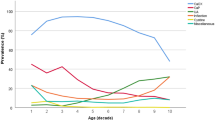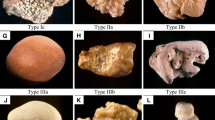Abstract
To examine the changes in stone composition from 1990 to 2010. A retrospective review was performed of all renal and ureteral stones submitted from the state of Massachusetts to a single laboratory (Laboratory for Stone Research, Newton, MA) for the years 1990 and 2010. Stone composition was determined by infrared spectroscopy and/or polarizing microscopy. A total of 11,099 stones were evaluated (56.7 % from 1990, 43.3 % from 2010). From 1990 to 2010, the percentage of stones from females (i.e., female/male ratio) increased significantly (29.8 % in 1990 to 39.1 % in 2010, p < 0.001). Among women, from 1990 to 2010, there was a significant increase in stones which were >50 % uric acid (7.6–10.2 %, p < 0.005) and a significant decrease in struvite stones (7.8–3.0 %, p < 0.001). Among women with calcium stones, the % apatite per stone decreased significantly (20.0 vs. 11.7 %, p < 0.001). Among men, there were no changes in stones which were majority uric acid (11.7–10.8 %, p = 0.2). Among men with calcium stones, the % apatite per stone increased significantly (9.8 vs. 12.5 %, p < 0.001). Males also demonstrated a significant increase in both cystine (0.1–0.6 %, p < 0.001) and struvite stones (2.8–3.7 %, p = 0.02). The epidemiology of stone disease continues to evolve and appears to vary according to gender. While some of these findings may be related to population changes in body mass index and obesity, the etiology of others remains unclear.


Similar content being viewed by others
References
Parks JH, Coe FL (1996) The financial effects of kidney stone prevention. Kidney Int 50:1706
Powis SJ, Black J, MacDougall JA et al (1974) Management of patients with urinary calculi. Br Med J 1:355
Curhan GC (2007) Epidemiology of stone disease. Urol Clin North Am 34:287
Grases F, Costa-Bauza A, Prieto RM (2006) Renal lithiasis and nutrition. Nutr J 5:23
Lieske JC, de la Pena Vega LS, Slezak JM et al (2006) Renal stone epidemiology in Rochester, Minnesota: an update. Kidney Int 69:760
Scales CD Jr, Smith AC, Hanley JM et al (2012) Prevalence of kidney stones in the United States. Eur Urol 62:160
Knoll T, Schubert AB, Fahlenkamp D et al (2011) Urolithiasis through the ages: data on more than 200,000 urinary stone analyses. J Urol 185:1304
Jing Z, GuoZeng W, Ning J et al (2010) Analysis of urinary calculi composition by infrared spectroscopy: a prospective study of 625 patients in eastern China. Urol Res 38:111
Johnson CM, Wilson DM, O’Fallon WM et al (1979) Renal stone epidemiology: a 25-year study in Rochester, Minnesota. Kidney Int 16:624
Scales CD Jr, Curtis LH, Norris RD et al (2007) Changing gender prevalence of stone disease. J Urol 177:979
Huffman MD, Capewell S, Ning H et al (2012) Cardiovascular health behavior and health factor changes (1988–2008) and projections to 2020: results from the National Health and Nutrition Examination Surveys. Circulation 125:2595
Daudon M, Traxer O, Conort P et al (2006) Type 2 diabetes increases the risk for uric acid stones. J Am Soc Nephrol 17:2026
Taylor EN, Stampfer MJ, Curhan GC (2005) Diabetes mellitus and the risk of nephrolithiasis. Kidney Int 68:1230
Jeong JY, Doo SW, Yang WJ et al (2011) Differences in urinary stone composition according to body habitus. Korean J Urol 52:622
Hesse A, Heimbach D (1999) Causes of phosphate stone formation and the importance of metaphylaxis by urinary acidification: a review. World J Urol 17:308
Chou YH, Su CM, Li CC et al (2011) Difference in urinary stone components between obese and non-obese patients. Urol Res 39:283
Parks JH, Worcester EM, Coe FL et al (2004) Clinical implications of abundant calcium phosphate in routinely analyzed kidney stones. Kidney Int 66:777
Choi JW, Song PH, Kim HT (2012) Predictive factors of the outcome of extracorporeal shockwave lithotripsy for ureteral stones. Korean J Urol 53:424
Menke A, Rust KF, Fradkin J et al (2014) Associations between trends in race/ethnicity, aging, and body mass index with diabetes prevalence in the United States: a series of cross-sectional studies. Ann Intern Med 161:328
Eggermann T, Venghaus A, Zerres K (2012) Cystinuria: an inborn cause of urolithiasis. Orphanet J Rare Dis 7:19
Asplin DM, Asplin JR (2013) The Interaction of thiol drugs and urine pH in the treatment of cystinuria. J Urol 189:2147
Fwu CW, Eggers PW, Kimmel PL et al (2013) Emergency department visits, use of imaging, and drugs for urolithiasis have increased in the United States. Kidney Int 83:479
Eisner BH, Deshmukh SM, Lange D (2014) Struvite Stones. In: Grasso M, Goldfarb DS (eds) Urinary stones: medical and surgical management. Wiley, New York
Conflict of interest
The authors declare that they have no conflicts of interest associated w/the publication of this manuscript. Rachel Moses, Vernon M. Pais Jr, Michal Ursiny, Edwin Prien Jr, Nicole Miller—none Brian Eisner—consultant for Boston Scientific, Bard, Cook, Olympus, PercSys, Radius Pharma-ceuticals; Owner—Ravine Group.
Author information
Authors and Affiliations
Corresponding author
Rights and permissions
About this article
Cite this article
Moses, R., Pais, V.M., Ursiny, M. et al. Changes in stone composition over two decades: evaluation of over 10,000 stone analyses. Urolithiasis 43, 135–139 (2015). https://doi.org/10.1007/s00240-015-0756-6
Received:
Accepted:
Published:
Issue Date:
DOI: https://doi.org/10.1007/s00240-015-0756-6




